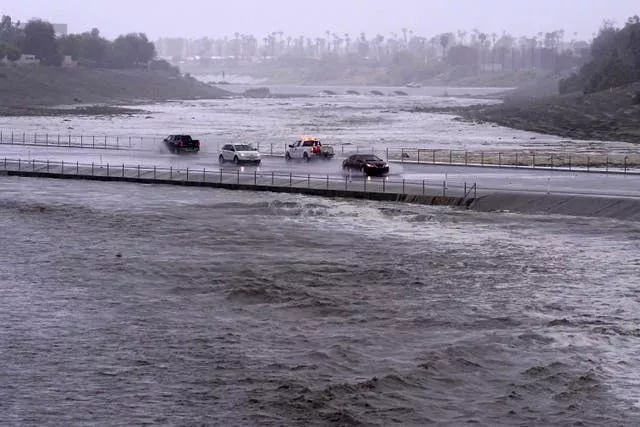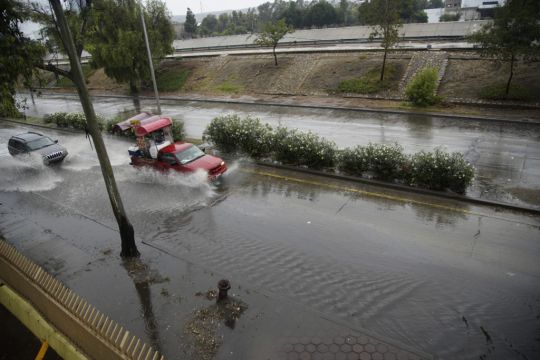Tropical Storm Hilary has deluged arid parts of Mexico and then drenched Southern California from the coast to inland mountains and deserts, forcing rescuers to pull several people from swollen rivers.
Millions of people expect more flooding and mudslides on Monday, even as the storm begins to weaken.
The storm first made landfall in Mexico’s arid Baja California Peninsula on Sunday in a sparsely populated area about 150 miles south of Ensenada.
One person drowned.
It then moved through mudslide-prone Tijuana, threatening the improvised homes that cling to hillsides just south of the US border.
The first tropical storm to hit Southern California in 84 years, Hilary dropped more than half an average year’s worth of rain on some areas, including the desert resort city of Palm Springs, which saw nearly 3in of rain by Sunday evening.

The US National Hurricane Centre in Miami downgraded Hilary to a post-tropical storm in its early Monday advisory, and warned that “continued life-threatening and locally catastrophic flooding” was expected over portions of the south-western US on Monday. All coastal warnings were discontinued.
Forecasters warned of dangerous flash floods across Los Angeles and Ventura Counties, and fire officials rescued 13 people from knee-deep water in a homeless encampment along the rising San Diego River.
Meanwhile, rain and debris washed out some roadways and people left their cars stranded in standing water. Crews pumped floodwaters out of the emergency room at Eisenhower Medical Center in Rancho Mirage.
The Los Angeles Unified School District, the nation’s second largest school system, said all campuses would be closed on Monday, as did districts across the region.
San Diego schools postponed the first day of classes from Monday to Tuesday.
The Palm Springs Police Department said on Sunday that 911 lines were down and that in the event of an emergency to text 911 or reach out to the nearest police or fire station.
8PM EDT Aug 20: The system in the Gulf of Mexico has a high chance of formation. Interests in the western Gulf of Mexico should monitor the progress of this system. Tropical storm watches or warnings may be necessary on Monday. Visit https://t.co/tW4KeGe9uJ for the latest pic.twitter.com/o3gvvIOXLI
— National Hurricane Center (@NHC_Atlantic) August 21, 2023
The storm was projected to weaken as it continued moving northward over California and into Nevada, but Richard Pasch, a hurricane specialist with the National Hurricane Center, said “very heavy” rain and strong winds are still likely.
Southern California got another surprise on Sunday afternoon as an earthquake with a preliminary magnitude of 5.1 hit near Ojai, about 80 miles north-west of Los Angeles, according to the US Geological Survey.
The tremor was felt widely and was followed by smaller aftershocks. There were no immediate reports of major damage or injury, according to a dispatcher with the Ventura County Sheriff’s Office.
Hilary is just the latest major climate disaster to wreak havoc across the US, Canada and Mexico.
Hawaii’s island of Maui is still reeling from a blaze that killed over 100 people and ravaged the historic town of Lahaina, making it the deadliest US wildfire in more than a century. Firefighters in Canada are battling that nation’s worst fire season on record.
As Hilary bore down on Mexico, one person drowned on Saturday in Mugele, on the eastern side of the Baja Peninsula, when a vehicle was swept away by an overflowing stream.

Rescue workers saved four other people, said Edith Aguilar Villavicencio, the mayor of Mulege.
Mexican army troops fanned out across the area where some of the worst damage occurred on Saturday.
Soldiers used bulldozers and dump trucks to help clear tons of boulders and earth that clogged streets and roads. Power lines were toppled in many places, and emergency personnel worked to restore electricity.
Also on Sunday, one of several budding storm systems in the Atlantic Ocean became Tropical Storm Emily, according to the National Hurricane Centre.
It was far from land, moving west in the open ocean. Meanwhile, Tropical Storm Franklin formed in the eastern Caribbean. Tropical storm watches were issued for the southern coasts of Haiti and the Dominican Republic.
In September 1939, a tropical storm that roared into California ripped apart train tracks, tore houses
from their foundations and capsized many boats, killing nearly 100 people on land and at sea.







